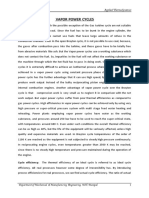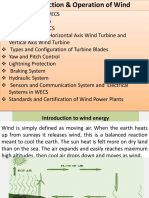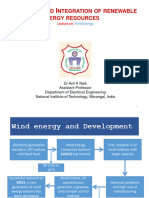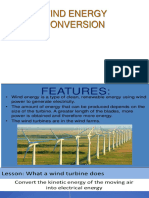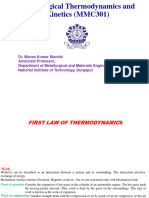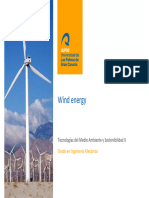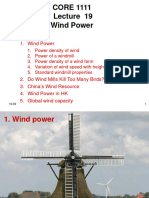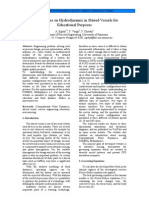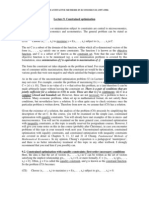Modeling and Analysis of Water Pumping Windmills
Modeling and Analysis of Water Pumping Windmills
Uploaded by
Syaiful AmrieCopyright:
Available Formats
Modeling and Analysis of Water Pumping Windmills
Modeling and Analysis of Water Pumping Windmills
Uploaded by
Syaiful AmrieOriginal Description:
Original Title
Copyright
Available Formats
Share this document
Did you find this document useful?
Is this content inappropriate?
Copyright:
Available Formats
Modeling and Analysis of Water Pumping Windmills
Modeling and Analysis of Water Pumping Windmills
Uploaded by
Syaiful AmrieCopyright:
Available Formats
Modeling and Analysis of Water
Pumping Windmills
Tyler Zellmer, Nicholas Shaw, Yang Wang
ME 305 Design Project #1 (Dr. Wagner)
22 October 2010
2
1. INTRODUCTION (BRIEF SYNOPSIS)
The main objective of the design project was to conduct a thorough analysis of a water
pumping windmill. Hired as engineering consultants, our team was challenged to complete
various assignments including: formulating sufficient assumptions, constructing appropriate free
body diagrams, numerically investigating the pumps dynamic behavior, and generating the
systems transient response through graphical plots. Moreover, our research was governed by
surrounding parameters including: gear train, blade, and mechanical linkage dimensions, net
torque influencing the gearbox, kinematic motion for each component, and the effects of
modifying the pumps system. In addition, MATLAB and Simulink simulation tools were
utilized to aid our study. Beforehand, it was essential that our engineering team identified and
fully understood all problems addressed, so we had the opportunity to deliver optimal system
results. The following report elaborates on significant issues encountered, thought out strategies,
and comprised solutions.
2. DESIGN APPROACH (MATHEMATICAL MODELING)
Our teams study was founded on basic assumptions for the key parameters of each
mechanical component. First, we assumed the gears and linkage to be ideal, and manufactured
as rigid bodies, containing no deformation; this proved to simplify our calculations.
Furthermore, the inertial effects for the gears and linkage were not taken into consideration when
formulating an equation following Newtons Second Law. Secondly, we made the assumption
that the empty space between the blades on the wind wheel comprised 30 percent of the total
wind wheel area. Other assumptions included modeling the blades as flat, smooth and composed
of aluminum material. Furthermore, we assumed the inertial effects from the windmill operated
as a flywheel to maintain a semi-steady angular velocity. With this in mind, our team neglected
changes in kinetic energy of the pump assembly. Lastly, we applied the incompressible
assumption for the given fluid (water), which suggests waters change in density () relative to
change in pressure (p) was negligible.
In our research, it was imperative to construct appropriate free body diagrams when
analyzing and solving the kinematics for the windmills system. Significantly, this worked to
our advantage in examining the systems individual components and revealing the difficulties in
determining acceptable dimensions. Figure 3.1 is an illustration of the systems main
components including: wind speed input, wind wheel blades, gear box, mechanical linkage,
water reservoir, and water released. As shown, the system is set in motion with a known input
wind speed. To support our analysis, the instructor provided wind speeds on a typical day,
ranging from 3-8 meters/second. From this point, a torque is generated through the wind wheel
blades and passed along through the gear box. Using methods acquired in ME 202 and ME 305,
we were able to discover the amplification or reduction in torque needed to further drive the
system; the gearbox shaft input torque varied from the initial wind speed torque.
3
FIGURE 2.1 Illustration of Complete Water Pumping Windmill System
Simply, torque was calculated using Equation 2.1, in which T is the net torque, J is the mass
inertia, and a (
) is the angular acceleration.
(2.1)
Also, our team utilized the gear train ratio among the driver gear (1) and the driven gear (2)
to solve for the gear box output torque produced. The ratio was calculated using the equation
shown below.
Gear Train Ratio =
(2.2)
Once
had been obtained, we then proceeded to examine the systems linkage. Our group
agreed to replicate a slider-crank mechanism, eliminating the difficulty in kinematic relations.
Wind Wheel Blades
Input
Wind Speed U
Water Reservoir (Pump)
1
2
Linkage
x
Output
Water Released
h L
Gear Box
4
Also, we believed the slider-crank would be the best way to model the water drive mechanism
with open cup for the cylinder pumping effect.
The image shows several variables used to calculate lengths as h represents height of the
pump at any given moment in time, L represents the length of the connecting rod, and s
represents the total stroke length. To compute h, we used Equation 2.3 presented below; this
equation was derived using the Law of Cosines, shown in Appendix A. Hence, this equation
allowed us to calculate the position of the slider at any given crank arm angle. In addition,
velocity and acceleration of the slider could be achieved by calculating the derivatives of h.
h = s * + L
((
))
(2.3)
Next, we focused on the study of the water reservoir, also known as the water pump.
Referring back to the slider-crank, the force due to the weight of the water was obtainable using
Equation 2.4, where V is the volume of a cylinder. Then, the system generates an output of
water released and reiterates the processes previously discussed.
(2.4)
Briefly mentioned earlier, we had to take into account the resistive torque opposed to the
torque produced by the windmill. To further explain, the resistive torque is created by the weight
of the water when being pumped. Equation 2.5 describes how to calculate the resistive torque,
(2.5)
In order to obtain the windmills torque, it was first necessary to calculate the total area of the
wind wheel. Importantly, the final numerical value was multiplied by a factor of .70, accounting
for 30 percent of empty space among the blades. The total surface area of the wind wheel,
, is presented below in Equation 2.6 where r
outer
represents the outer radius of the
wheel, and r
inner
represents the inner radius of the wheel.
(2.6)
At this point, it was possible to solve for the torque generated by the wind flowing across the
windmill. As shown in Figure 2.1, the torque output by the windmill would be directed through
the gear box and into the crank-slider mechanism. Before research, the instructor provided the
governing equation for torque as a function of wind speed as shown in Equation 2.7. The
windmills torque has a number of parameters including: density of air,
; total surface of the
wind wheel,
; a constant value, a; and wind speed, U.
(2.7)
5
Figure 2 is a free body diagram of the rotational system, offering a visual for both the
windmill and resistive torques, mass rotation, gear train, and damping. The diagram follows the
same order of the full system displayed in Figure 1. However, this figure introduces frictional
damping yielded from various sources including the gearbox, water pump, and slider-crank
mechanism. To reduce efforts in calculating the damping for the system, we decided to match
our damping variable, b, with a real world value from a windmill flow rate.
FIGURE 2.2 Free body Diagram of Rotational Motion for the System
Other than the number of gear teeth, N, all the other variables are defined previously.
Initially, we acquired all the elements and studied the relationships among the variables to solve
the equation of motion for the system. The elements and relationships are as follows:
Elements:
Relationship 1:
)=
Relationship 2: (
Relationship 3: (
)= r
From this point, we referred back to Equations 2.1 and 2.5, and plugged in the relationships
and elements previously established. Finally, the equation of motion is obtained in Equation 2.8.
= r (
) -
= r (
) (
) (2.8)
All collected data and results from previous equations are presented in the next section. Also,
MATLAB code and derivation are displayed in Appendix A.
Y
X
Z
T
out
6
3. RESULTS AND DISCUSSION
In completing the project, our team was directed to develop a method and incorporate various
inputs to stimulate our dynamic system. Table 3.1 displays the input values for the windmill
system. The following input values were utilized for graphs 3.1, 3.2, 3.3, 3.4, and 3.5.
Design Parameter Value
Wind Speed 8 m/s
Wind Variance 0.5 m/s
Wind Frequency 10 sec/oscillation
Outer Radius of Windmill 6 ft
Inner Radius of Windmill 2 ft
Windmill Gear 25 Teeth
Crank Gear 50 Teeth
Stroke Length 6 in
Connecting Rod Length 18 in
Diameter of Pipe 5.5 in
TABLE 3.1 Design Parameters For Dynamic System
In addition, our group generated a series of time-response graphical plots for various
combinations of the system parameters and operating conditions. This task was accomplished
using MATLAB which provided an output. Figure 3.1 is a graphical representation of the
windmills angular velocity vs. time. Clearly, the graph shows the windmill rapidly increasing
during the first 5 seconds and fluctuates for the remainder of the trial. As shown, angular
velocity reaches its maximum value of an estimated 2.24 radians/second and with a period of 10
seconds. The change in final angular velocity was a result of the varying input wind speed.
FIGURE 3.1 Graphical Representation of Windmills Angular Velocity vs. Time
7
Figure 3.2 shows the linear relationship of the windmills angular position along with time.
As time increases, the angular position steadily increases. Furthermore, this graph has a positive
correlation; position is the dependent variable and time is the independent variable.
FIGURE 3.2 Graphical Representation of Windmills Angular Position vs. Time
Figure 3.3 exhibits the height of the open cup for the cylinder vs. time. The resistance force
from the weight of the water acting on the pump resembled a step function. As the pump moved
down, no water was stored and the net torque of the system decreases which causes a negative
slope. On the other hand, a resistive force initiated an impulse as the pump translated back to the
surface; the cup reaches a maximum height of ~.6 meters. The height of the cup were a function
of theta, as shown in Equation 2.3
FIGURE 3.3 Graphical Representation of Height of Cup vs. Time
8
Figure 3.4 is an illustration of the systems volumetric flow rate opposed to time. The flow
rate varies sinusoidally due to the sinusoidal motion of the cup, as discussed above, and the
amplitude varies due to the variance in angular velocity (which was itself caused by the variance
in wind speed. After converting to gallons per hour, the root-mean-square value was calculated
to be 2201 gal/hr.
FIGURE 3.4 Graphical Representation of Volumetric Flow Rate vs. Time
Figure 3.5 displays the generated gearbox torque vs. time. Clearly, the system has a peak
value of torque when t = 0 seconds. Initially, the gear box is subjected to no damping forces; as
angular velocity increases, damping increases, causing the resistive torque to increase as well.
This results in an overall decrease in net torque. As the system moves towards a stable velocity,
acceleration declines. Thus, the systems net torque reduces to a minimal average value of zero.
FIGURE 3.5 Graphical Representation of Gearbox Torque vs. Time
9
Through discussion, we hypothesized that the volumetric flow rate would decrease if average
wind speed was lowered. Making these assumptions, we believed the system would generate a
lower damping force and would produce smoother graphical plots. After altering the wind speed
to a value of 6 meters/second, our hypothesis was correct. Figure 3.6 represents the systems
volumetric flow rate, whose RMS value was converted to 1244 gal/hr. One can see that the
frequency of the pumping action has decreased. This is the result of a lower average windmill
velocity, shown in Figure 3.7. This lower velocity is expected, and caused by the lower wind
speed.
FIGURE 3.6 Graphical Representation of Flow Rate vs. Time
FIGURE 3.7 Graphical Representation of Angular Velocity vs. Time
10
The selection of the gear train and mechanical linkage design played a critical role in
optimizing the systems performance. The difficulty of selecting the gear train became known
when using Equation 2.2. In summary, we were sure to select gears easily obtainable in real life
that would produce a ratio sufficient to drive the system. After a series of trial-and-error
calculations involving various ratios, we felt comfortable with a windmill gear of 25 teeth and
crank gear of 50 teeth. To our advantage, this gear selection produced a simple, calculable ratio.
When selecting the mechanical linkage, we became familiar with a crank-slider mechanism, as
previously stated. The stroke length was chosen to be 6 inches, based on information provided
by Aermotor. Based on geometry of the mechanism, this meant the crank arm for the pump
would be 3 inches. Again, using geometric techniques and given information from Aermotor,
we decided on a connecting rod length of 18 inches. To illustrate the effects of these parameters,
the model shown in Figure 3.1 has been changed to show a windmill without a reduction gear (or
rather, a 1:1 direct-drive gearbox).
FIGURE 3.8 Graphical Comparison of Reduction Gear Ratios
As seen, the removal of the reduction gear greatly decreased the angular velocity of the
system, and therefore the output. Root-mean-square output of this system was calculated to be
978 gal/hr, compared to 2201 gal/hr for the system with the reduction gear.
Knowing the selection of the damping constant b would vastly affect our system dynamics, it
was decided that the best course of action would be to model the windmill after a physical
2:1 Reduction Gear
No Reduction Gear
11
product available from Ironman. The smallest windmill available from Ironman was 8 feet in
diameter. All parameters in our model were set to replicate the Ironman windmill, and the
damping constant was adjusted in order to produce a flow rate similar to that of the real
windmill. The Pumping Chart capacity from the website gave a flow output of 1,700 gallons per
hour at medium wind speed, and our model calculated an output of 1840 gallons per hour at
6m/s. However, since residential policy limits windmill blade diameter to 6 feet, our final
windmill was downsized to fulfill this restriction.
4. SUMMARY
Altogether, its vital that we as engineers understand the importance of procedures taken
when modeling and analyzing any engineering system. In this case, our aim focused on the
investigation of water pumping windmills. Through analysis, we made appropriate assumptions,
examined real world models, and constructed a mathematical windmill model supported by
calculated data. In addition, the project called for the use of simulation, testing the system under
different operating conditions, and representation of performance through graphical plots. Based
on observation, our system operated under all given conditions and delivered optimal results.
Therefore, the modeling and analysis of a windmill were executed successfully.
5. APPENDICES
APPENDIX A DERIVATION OF EQUATION 2.3
(2.3)
APPENDIX B PROJ_WINDMILL.M
% Windmill Flow Calculation Program proj_windmill.m
% Tyler Zellmer, Nick Shaw, Yang wang
clc; clear;
% Input Variables
speed = 8; % Average wind speed, in m/s
v = 0.5; % Variance in wind speed (+/-)
fr = 10; % Frequency of oscillations, in seconds / oscillation
time = 40; % Time to run simulation, in s
step = .01; % Resolution of simulation, in s
12
% Windmill Constants
d1 = 6; % Outer diameter of windmill blades, in ft
d2 = 2; % Inner diameter of windmill blades, in ft
th = 3; % Thickness of blade "disk", in inches
a = .5; % Value of a, given in class
n1 = 25; % Number of teeth on windmill shaft gear
n2 = 50; % Number of teeth on crank gear
s = 6; % Desired stroke length, in inches
l = 18; % Length of connecting rod, in inches
d_pipe = 5.5; % Diameter of pipe, in inches
% Physical Constants
rho_air = 1.23; % Density of air at STP, in kg/m^3
rho_al = 2700; % Density of blades (assumed aluminum), in kg/m^3
rho_wat = 1000; % Density of water, in kg/m^3
g = -9.81; % Gravity acceleration, in m/s
% Damping constant (see report for explanation on this number)
b = 30;
% Calculate area of windmill
a_s = pi()*(d1^2-d2^2)/4;
a_s = a_s*.3048*.7; % Convert to square meters, assuming 30% of the
% circle area is empty space between blades
% Calculate weight of water in each stroke
s = s*.0254; % Convert stroke length to meters
l = l*.0254; % Convert rod length to meters
d_pipe = d_pipe*.0254; % Convert diameter of pipe into meters
a_pipe = pi()*(d_pipe/2)^2; % Find cross sectional area of pipe
v_stroke = a_pipe*(s); % Find volume of each stroke
w = rho_wat*g*v_stroke; % Weight = specific gravity * volume
% Calculate moment of inertia for front blade
d1 = d1 * 0.3048; % Convert diameter to meters
d2 = d2 * 0.3048; % Convert diameter to meters
th = th * 0.0254; % Convert thickness to meters
m = pi() * ((d1/2)^2 - (d2/2)^2) * th * rho_al; % Calculate mass = V*rho
J = m*((d1/2)^2-(d2/2)^2)/2;
% Run diff eq simulation in Simulink
option = simset('MaxStep', step);
sim('windspeed',time, option);
% Interpret results
omega = ang_velocity.signals.values;
theta = angle.signals.values;
% Calculate height and velocity of cup at every instant
height = (s+l)-(s - s*cos(theta)+l-sqrt(l^2-(s*sin(theta)).^2));
% Calculate velocity of fluid at each time instant
for (j=1:1:length(theta))
% Calculate the velocity of the fluid using the derivative of the
% height.
13
velocity(j) = -s*sin(theta(j))-
(s^2*sin(theta(j))*cos(theta(j)))/sqrt(l^2-(s^2*(sin(theta(j)))^2));
velocity(j) = velocity(j)*omega(j);
% If the pump is going down, the velocity of the fluid is zero.
if velocity(j)<0
velocity(j)=0;
end
end
% Calculate flow rate from velocity, in m^3/s
Q = velocity .* a_pipe;
% Calculate average flow rate over whole simulation
Q_mean = mean(Q) * 951019 % In gallons/hour
Q_RMS = rms(Q) * 951019 % Root-mean-square average, in gal/hr
% Plot results
% Angular velocity vs time
figure(1)
plot(ang_velocity.time, omega);
title('Angular Velocity vs Time');
xlabel('Time (sec)');
ylabel('Angular Velocity (Rad/s)');
% Angle vs time
figure(2)
plot(angle.time, theta);
title('Angular Position vs Time');
xlabel('Time (sec)');
ylabel('Angle (Rad)');
% Height vs time
figure(3)
plot(angle.time, height);
title('Height of Cup vs Time');
xlabel('Time (sec)');
ylabel('Height of Pump (m)');
% Flow rate vs time
figure(4)
plot(angle.time, Q);
title('Flow rate vs Time');
xlabel('Time (sec)');
ylabel('Flow rate (m^3/s)');
%Gearbox torque vs time
figure(5)
plot(angle.time, Tnet.signals.values)
title('Gearbox Torque vs Time');
xlabel('Time (sec)');
ylabel('Torque (Nm)');
%animation(theta, omega, step, 6, height, s);
14
APPENDIX C SIMULINK DESIGN (SEE ATTACHED)
APPENDIX D SUMMARY OF RESULTS (TABULATED)
System Description Output Flow Rate (Q
RMS
, gal/min)
6m/s windspeed, 8ft blade 1840
8m/s windspeed, 6ft blade 2201
6m/s windspeed, 6ft blade 1244
8m/s windspeed, 6ft blade, no reduction 978
6. REFERENCES
1. "Aermotor Windmill Company Inc.- Economical Energy Wind Water Pump -
Welcome." Aermotor Windmill Company Inc.- Economical Energy Wind Water Pump
- Welcome. N.p., n.d. Web. 6 Oct. 2010. <http://www.aermotorwindmill.com/>.
2. Behrens, Stephannie. Spur Gears. Carnegie Mellon University. Rapid Design
through Virtual and Physical Prototyping: I ntroduction to Mechanisms. Web. 19 Oct.
2010.
3. Feldman, Phillip M. MathWorks Function for Root-Mean-Square in MatLab, rms.m
31 March, 2006. Web. 17 October 2010.
4. How Water Pumping Windmills Work. Ironmanwindmill.com. Ironman
Windmill Co., n.d. Web. 15 Oct. 2010.
5. Lange, Atelier. Wind Wheel. Oberhausen, Germany. atelier-lange.de/objects.
April. 2009. Web. 19 October 2010.
6. Ruegen, Norman. Windmill. flickr.com/photos/norman_ruegen. 21 May 2005.
Web. 18 October 2010.
You might also like
- Project ReportDocument75 pagesProject Reportmrishal100% (7)
- Renewable Energy 2022-23Document39 pagesRenewable Energy 2022-23michaelprriorNo ratings yet
- Engineering Utilities Lecture 12 Part 2Document28 pagesEngineering Utilities Lecture 12 Part 2Hiiragi YunoNo ratings yet
- Lecture Notes 2.7.0Document18 pagesLecture Notes 2.7.0krsdz1500No ratings yet
- Unit III - RETDocument46 pagesUnit III - RETsagarpatil03012No ratings yet
- Vapor Power CyclesDocument48 pagesVapor Power CyclesJames WankerNo ratings yet
- 10 Wind Energy PhysicsDocument39 pages10 Wind Energy PhysicsBereket YohanisNo ratings yet
- Wind Energy Lecture 11 12Document21 pagesWind Energy Lecture 11 12abdulrafaykamalNo ratings yet
- Wind Energy Conversion SystemsDocument18 pagesWind Energy Conversion Systemsotibhor.ikuenobeNo ratings yet
- L6-Wind Power-1Document20 pagesL6-Wind Power-1Lim VanthienNo ratings yet
- Fundamentals of Wind Energy Conversion System Control V 16.0Document98 pagesFundamentals of Wind Energy Conversion System Control V 16.0Jordi CarbonellNo ratings yet
- Unit II-NOTES For IA1Document30 pagesUnit II-NOTES For IA1anks202No ratings yet
- Revised 14 Lecture (EE-414)Document48 pagesRevised 14 Lecture (EE-414)shumailanoor.salahuddinNo ratings yet
- Chapter 52 Wind PPDocument48 pagesChapter 52 Wind PPmatusala abhaNo ratings yet
- Fundamentals of Wind EnergyDocument12 pagesFundamentals of Wind EnergyMas3odNo ratings yet
- Wind Energy Systems - Unit 3Document224 pagesWind Energy Systems - Unit 3Gülhüseyn SadıqlıNo ratings yet
- ECE3072 Sp21 Lecture 9 HydroDocument78 pagesECE3072 Sp21 Lecture 9 HydroNik ChoNo ratings yet
- Me18405 FMMDocument426 pagesMe18405 FMMRohan ChavhanNo ratings yet
- Lecture 6Document87 pagesLecture 6terabyte2408No ratings yet
- Lecture 22Document43 pagesLecture 22Navdeep SinghNo ratings yet
- Mechanical Control of Wind Turbine: Payal Gupta Advisor: Dr. Ovidiu CrisanDocument22 pagesMechanical Control of Wind Turbine: Payal Gupta Advisor: Dr. Ovidiu CrisanPayal GuptaNo ratings yet
- Fundamentals of Wind EnergyDocument26 pagesFundamentals of Wind EnergyMas3odNo ratings yet
- A7Document68 pagesA7HailayNo ratings yet
- Wind Power Generation - 1Document34 pagesWind Power Generation - 1Alfered CanistusNo ratings yet
- MA4819 Wind Energy 2324 Part1 ClassDocument50 pagesMA4819 Wind Energy 2324 Part1 Classberwin.pshNo ratings yet
- Wind Energy Conversion SystemDocument84 pagesWind Energy Conversion SystemcharlesNo ratings yet
- Unit 3Document80 pagesUnit 3VELUANBALAGANNo ratings yet
- 3ME5568-Chapter 2 - Lecture WINDDocument27 pages3ME5568-Chapter 2 - Lecture WINDArmando Rodríguez CevallosNo ratings yet
- Lecture 4 - 2024Document36 pagesLecture 4 - 2024mehdi.znu.abNo ratings yet
- Lecture MMC301 Up To 05-09-2023 PDFDocument74 pagesLecture MMC301 Up To 05-09-2023 PDFashutoshranjan275No ratings yet
- Energy AnginDocument45 pagesEnergy AnginAde Riyan HidayatNo ratings yet
- Mec 551 ConvectionDocument174 pagesMec 551 ConvectionFikri RahimNo ratings yet
- Introduction WindenergyDocument33 pagesIntroduction Windenergyayash mohantyNo ratings yet
- Lecture - Wind Energy - 1Document47 pagesLecture - Wind Energy - 1Carlos BabuNo ratings yet
- Green Electric Energy Lecture 20Document50 pagesGreen Electric Energy Lecture 20dishantpNo ratings yet
- Capítulo 4Document30 pagesCapítulo 4Marisa CamachoNo ratings yet
- Chapter 3. Wind Power EnergyDocument42 pagesChapter 3. Wind Power EnergyzalomxisNo ratings yet
- Lecture 23Document53 pagesLecture 23Navdeep SinghNo ratings yet
- ME5521 Chapter4 2 2012Document51 pagesME5521 Chapter4 2 2012Sebastián EspinozaNo ratings yet
- Wind Energy: Under The Supervision Of: Prof. S.K. Shukla Department of Mechanical Engineering IIT (BHU), Varanasi-221005Document47 pagesWind Energy: Under The Supervision Of: Prof. S.K. Shukla Department of Mechanical Engineering IIT (BHU), Varanasi-221005shantanubanerjee.mec24No ratings yet
- Wind Energy SystemDocument28 pagesWind Energy SystemDanielK TetteyNo ratings yet
- Course MaterialDocument228 pagesCourse Materialmohtu92No ratings yet
- Lecture No 3Document95 pagesLecture No 3Raza AnsariNo ratings yet
- Wind Energy Systems - LecturesDocument49 pagesWind Energy Systems - LecturesHibaNo ratings yet
- Lec 2Document48 pagesLec 2Vishnu Vardhan Reddy BaitintiNo ratings yet
- Aerodynamics of Wind Turbines: Part - 3Document37 pagesAerodynamics of Wind Turbines: Part - 3John TauloNo ratings yet
- Aerodynamics Wind EnergyDocument25 pagesAerodynamics Wind Energyayash mohantyNo ratings yet
- Lecture 19 - Wind PowerDocument38 pagesLecture 19 - Wind PowerLi RanNo ratings yet
- Characteristic of Wind: Hartono BSDocument40 pagesCharacteristic of Wind: Hartono BSpenx2013No ratings yet
- Heat Transfer Chapter Two PDFDocument86 pagesHeat Transfer Chapter Two PDFteddiyfentawNo ratings yet
- Lec1 SSDocument44 pagesLec1 SSkaren dejoNo ratings yet
- Re451 - Week10 - Lecture 18Document67 pagesRe451 - Week10 - Lecture 18Athir TarrazNo ratings yet
- Wind EnergyDocument22 pagesWind EnergyShashika Amali SamaranayakeNo ratings yet
- Power Cycles 2 - Vapor PowerDocument48 pagesPower Cycles 2 - Vapor Powercan can100% (1)
- Lecture 22 - Rees - Sp-23Document52 pagesLecture 22 - Rees - Sp-23Hasan RazaNo ratings yet
- ME5207-Solar Cooling - Heating and Thermal Energy Storage ApplicationsDocument59 pagesME5207-Solar Cooling - Heating and Thermal Energy Storage Applications김동욱No ratings yet
- Distributed Generation: Prepared By: GEEDocument30 pagesDistributed Generation: Prepared By: GEETang SangngovNo ratings yet
- Kathmandu University: Useful Concepts On Operating of A Hydropower Plant of SystemDocument20 pagesKathmandu University: Useful Concepts On Operating of A Hydropower Plant of SystemBikalpa SharmaNo ratings yet
- Analysis of Wind Speed Data and Wind Energy Potential Along Selected Location in ChandwadDocument7 pagesAnalysis of Wind Speed Data and Wind Energy Potential Along Selected Location in ChandwadLokesh SarnotNo ratings yet
- Plugin-11745 Egedy PaperDocument5 pagesPlugin-11745 Egedy PaperMuhammad ImranNo ratings yet
- Control of DC Motor Using Different Control StrategiesFrom EverandControl of DC Motor Using Different Control StrategiesNo ratings yet
- 4-5-Security-Privacy Rules-LessonplanDocument4 pages4-5-Security-Privacy Rules-Lessonplanapi-97402456No ratings yet
- Life Sciences Study Materials Drawing Graphs 2012Document8 pagesLife Sciences Study Materials Drawing Graphs 2012api-202349222No ratings yet
- Dll-Science 7 Week 4Document4 pagesDll-Science 7 Week 4Percy Brenda ModeloNo ratings yet
- Kata Kunci: Malpraktik PerawatDocument14 pagesKata Kunci: Malpraktik PerawatMariaNo ratings yet
- Standardization of AdvertisementDocument18 pagesStandardization of AdvertisementNguyễn HàNo ratings yet
- CIS6011 CW2 2022 - Semester1Document15 pagesCIS6011 CW2 2022 - Semester1Ahamed MushtaaqNo ratings yet
- Quantitative Methods in Economics IIDocument8 pagesQuantitative Methods in Economics IIJoshi2014No ratings yet
- Homeschooling in The United States: A Review of Select Research TopicsDocument29 pagesHomeschooling in The United States: A Review of Select Research TopicsFazihar ZahariNo ratings yet
- Accentuate The Positive and The Negative Rethinking The Use of Self Esteem SelfDeprecation and Self ConfidenceDocument13 pagesAccentuate The Positive and The Negative Rethinking The Use of Self Esteem SelfDeprecation and Self ConfidenceVannay CuaresmaNo ratings yet
- Undergraduatebulletin2008 09Document630 pagesUndergraduatebulletin2008 09Stanley WangNo ratings yet
- JASANOFF. The Political Science of Risk PerceptionDocument9 pagesJASANOFF. The Political Science of Risk PerceptionanatilmauxNo ratings yet
- School Lac PlanDocument2 pagesSchool Lac PlanBONIFACIO ORGA100% (2)
- Oral History SocietyDocument13 pagesOral History SocietychnnnnaNo ratings yet
- Vocabulary Acquisition in English For MeDocument28 pagesVocabulary Acquisition in English For Mezakaria fantaziNo ratings yet
- Research ProposalDocument5 pagesResearch ProposalPIR AIZAZ ALI SHAHNo ratings yet
- V4es - StressDocument11 pagesV4es - StressSamiulla BabuNo ratings yet
- Drone SurveyDocument2 pagesDrone SurveySANAD 20GCE37No ratings yet
- Rhia P. Perez, PH.D: College of Teacher Education-Undergraduate ProgramDocument65 pagesRhia P. Perez, PH.D: College of Teacher Education-Undergraduate ProgramKassandra Kay De RoxasNo ratings yet
- Equity AnalysisDocument18 pagesEquity AnalysisashrithaNo ratings yet
- Fast-Food Model of EducationDocument6 pagesFast-Food Model of EducationLiezl Odeña CulanibangNo ratings yet
- Lesson 1: Inventions and Innovations: An Evolutionary ProcessDocument4 pagesLesson 1: Inventions and Innovations: An Evolutionary Processapi-291536771No ratings yet
- Design Expert 9 Users Guide MultifactorDocument53 pagesDesign Expert 9 Users Guide MultifactormasoudandyNo ratings yet
- Literature Review On Crime in NigeriaDocument10 pagesLiterature Review On Crime in Nigeriaafmzhpeloejtzj100% (1)
- Personality Theories Boeree PDF 2018Document147 pagesPersonality Theories Boeree PDF 2018MNo ratings yet
- SPIDER Tool - SummaryDocument4 pagesSPIDER Tool - Summarypriyayog1509No ratings yet
- MNO2603-101 2017 3 BDocument44 pagesMNO2603-101 2017 3 BMichael100% (1)
- Unit-2 SolutionDocument22 pagesUnit-2 SolutionAntonyManickarajNo ratings yet
- Advanced Practice NursingDocument11 pagesAdvanced Practice NursingSaher Kamal100% (2)
- HR: Line Function or Staff Function?: The Dilemma ContinuesDocument5 pagesHR: Line Function or Staff Function?: The Dilemma ContinuesBireswar DeysarkarNo ratings yet





